Lights to display
All vessels need lights to be seen at night and when visibility is limited. Here are the lights you must display and what they mean.
Navigation lights
The navigation lights you display on your vessel help keep everyone safe on the water. They show what size and type of vessel you're in, whether you're at anchor or underway, and your direction of travel.
You must display navigation lights:
- at night (from sunset to sunrise)
- at times of restricted visibility, such as when there’s fog, smoke or glare.
The types of navigation lights you must display depend on your vessel type and size.
Make sure that background lights or any other lights you use – such as spotlights – do not interrupt your night vision (or anyone else's).
It's recommended that all vessels carry a torch, where practical. This is in case you're caught out on the water at night. For example, if you're in a kayak and a strong current prevents you from returning to the shore before sunset.
Types of lights
All types of navigation lights have a range of visibility. This is the distance the light is visible from at night.
All round white light
An all round white light is a white light displaying an unbroken light over an arc of the horizon of 360 degrees. This light should not be obstructed by any part of the vessel or person.
Minimum range of visibility: 2nm This light should not be obstructed by any part of the vessel or person.

Masthead light
A masthead light is a white light placed over the centreline (bow to stern) of a vessel, displaying an unbroken light over an arc of the horizon of 225 degrees. It is fixed to display from anywhere ahead to just behind the beam of the vessel.
Minimum range of visibility:
- vessels up to 12m long: 2nm
- vessels between 12 and 20m long: 3nm
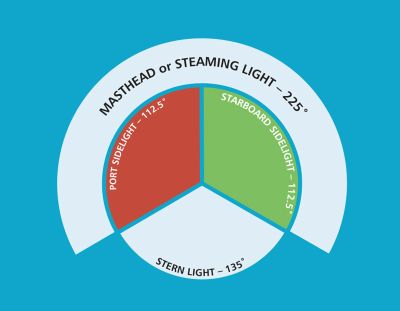
Sidelights
Sidelights are a green light on the starboard (right) side, and a red light on the port (left) side of a vessel. Each displays an unbroken light over an arc of the horizon of 112.5 degrees. Each is fixed to display from ahead to just behind the beam of the vessel on its respective side.
On vessels up to 20m long, the sidelights may be combined in one light unit, carried on the centreline (bow to stern) of the vessel.
Minimum range of visibility:
- vessels up to 12m long: 1nm
- vessels between 12 and 20m long: 2nm.
Sternlight
A sternlight is a white light placed near the stern, displaying an unbroken light over an arc of the horizon of 135 degrees. It is fixed to display from behind the vessel.
Minimum range of visibility: 2nm.
Combined lantern (tricoloured)
The combined lantern (tricoloured) is sidelights and sternlight combined at the top of the mast of a sailing boat.
It’s recommended that you do not use a combined lantern where there are lots of lights on the shore, for example, on Sydney Harbour. In these areas, use sidelights and a sternlight to make your vessel more visible.
Placement of lights
Navigation lights should be installed correctly so they display the appropriate arc of light and the minimum range of visibility. They should not be obscured by the vessel’s superstructure – such as the cabin – or occupants, or interfered with by deck lights. This reduces the vessel’s visibility and is dangerous.
It's recommended that lights are fitted by the vessel's manufacturer or an authorised person. Smaller vessels have a number of options, including bracketed or combination suction-capped lights. These are available from marine dealers.
Make sure sidelights are installed pointing out across the water. They should not point straight up or only forward.

The masthead and/or all round white light must be fitted (if practical) on the centreline (bow to stern) of the vessel. It must be mounted so that it's above any obstructions – such as the cabin or occupants – and so that it does not shine directly into the driver's eyes.

Lights to display at anchor
When at anchor, all vessels up to 50m long must display an all round white light in a place where it can best be seen.
When at anchor in a busy area, keep a proper lookout and display other lights – such as deck lights or cabin lights – to make sure you're seen.
Be aware that if your vessel displays sidelights when underway, you must switch those lights off when your vessel is at anchor.
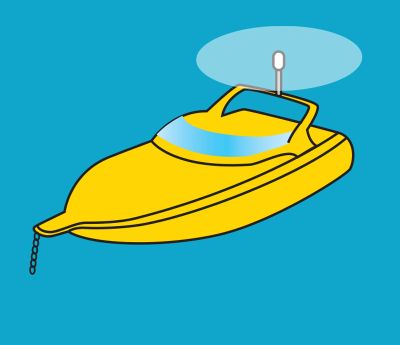
Lights to display when underway
The lights for a vessel underway depend on whether it's a powered or sailing vessel, and its size. This is so that other vessels can identify the type of vessel, how large it is, the direction it’s moving and how fast.
If your vessel is drifting, or making use of a GPS-guided electric engine to hold position, it's underway.
Powered vessels
Most powered vessels must display navigation lights.
Up to 7m long
If the vessel's maximum speed is 7 knots, it must have an all round white light and, if possible, separate and/or combined sidelights.
If the vessel can travel at a speed faster than 7 knots, the same rules as for powered vessels up to 12m long apply.
Up to 12m long
Must have separate or combined sidelights with either:
- a masthead light and a sternlight
- an all round white light.
The masthead or all round white light must be a minimum of 1m above the sidelights.
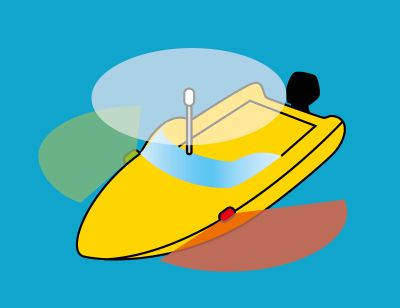
Between 12m and 50m long
Must have a masthead light a minimum of 2.5m above the gunwale and either:
- separate sidelights and a sternlight
- combined sidelights and a sternlight.
Combined sidelights must be a minimum of 1m below the masthead light.

Personal watercraft (PWC)
PWC do not have to carry lights, because they must not be on the water at night (between sunset and sunrise). However, it's recommended that you carry a torch when driving a PWC in case you’re caught out at times of restricted visibility.
Sailing vessels
Up to 7m long
Must display sidelights and a sternlight, if possible.
If it’s not possible to attach lights to the vessel – for example, on a small dinghy – use your torch.
Shining your torch on your sails or deck can help other vessels see you, and could help prevent a collision.

Between 7m and 20m long
Must display either:
- a combined lantern (with sidelights and a sternlight) at or near the top of the mast
- separate sidelights and a sternlight.
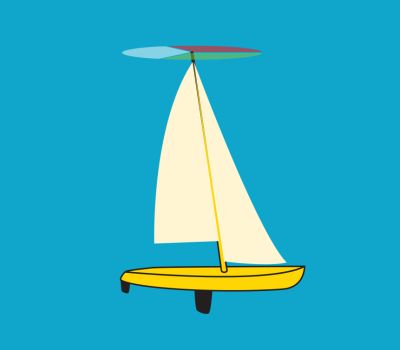
Over 20m long
Must display sidelights and a sternlight.
Must not carry a combined lantern.
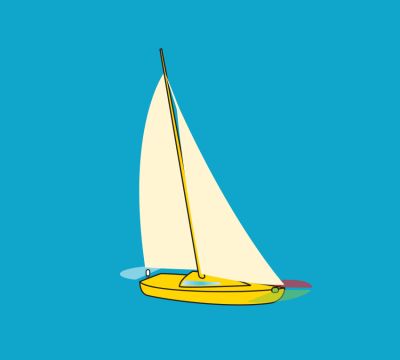
Optional lights
Sailing vessels using an engine must follow the same rules as powered vessels.
A sailing vessel of any length with sidelights and a sternlight (but not a combined lantern) may also carry 2 all round lights in a vertical line at or near the top of the mast. The upper light should be red and the lower light should be green.
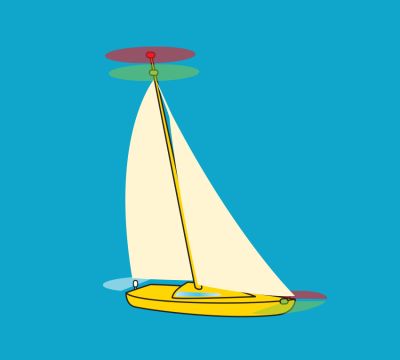
Paddlecraft and rowing vessels
Paddlecraft and rowing vessels must carry a torch or lantern displaying a white light. The light must be ready to display in time to prevent a collision.
This includes rowing shells and rowing boats, kayaks, canoes and surf skis, and powerboats and sailing boats being rowed.
If you're using a paddlecraft, it's recommended that you wear a head torch.
Over 4m long
It's recommended that paddlecraft and rowing vessels over 4m long also display:
- 2 all round white lights, one at each end of the vessel.
The lights can be continuous or a combination of continuous and flashing.
These recommended additional lights are set out in the Code of Conduct for Rowing.
Check your lights before heading out
Before going out on the water at night (between sunset and sunrise) or at times of restricted visibility:
- Check switches are on.
- Check navigation lights are on and working.
- Look at each light to check it is on.
- Turn off all other lights and dim electronic displays so they do not reduce your night vision.